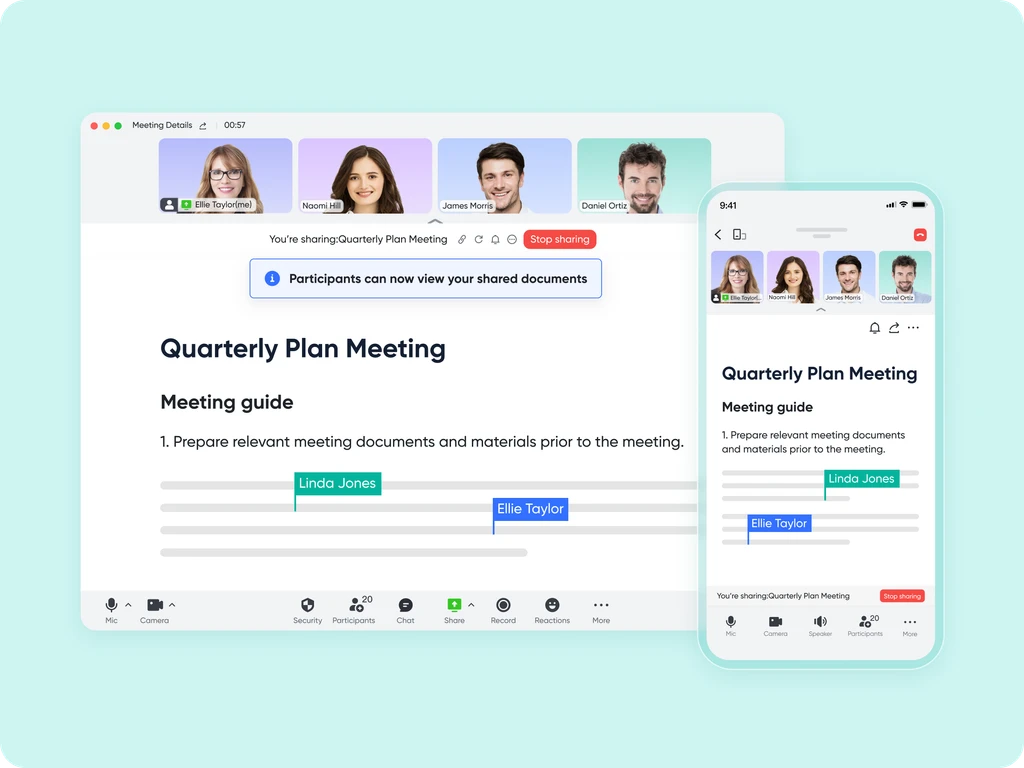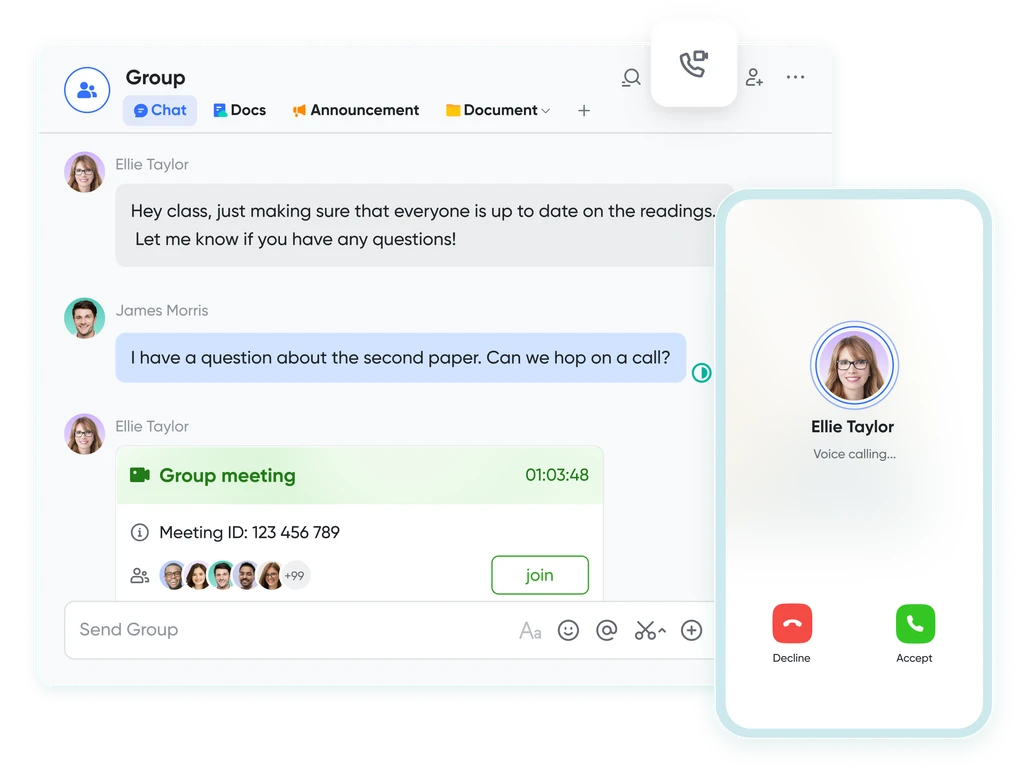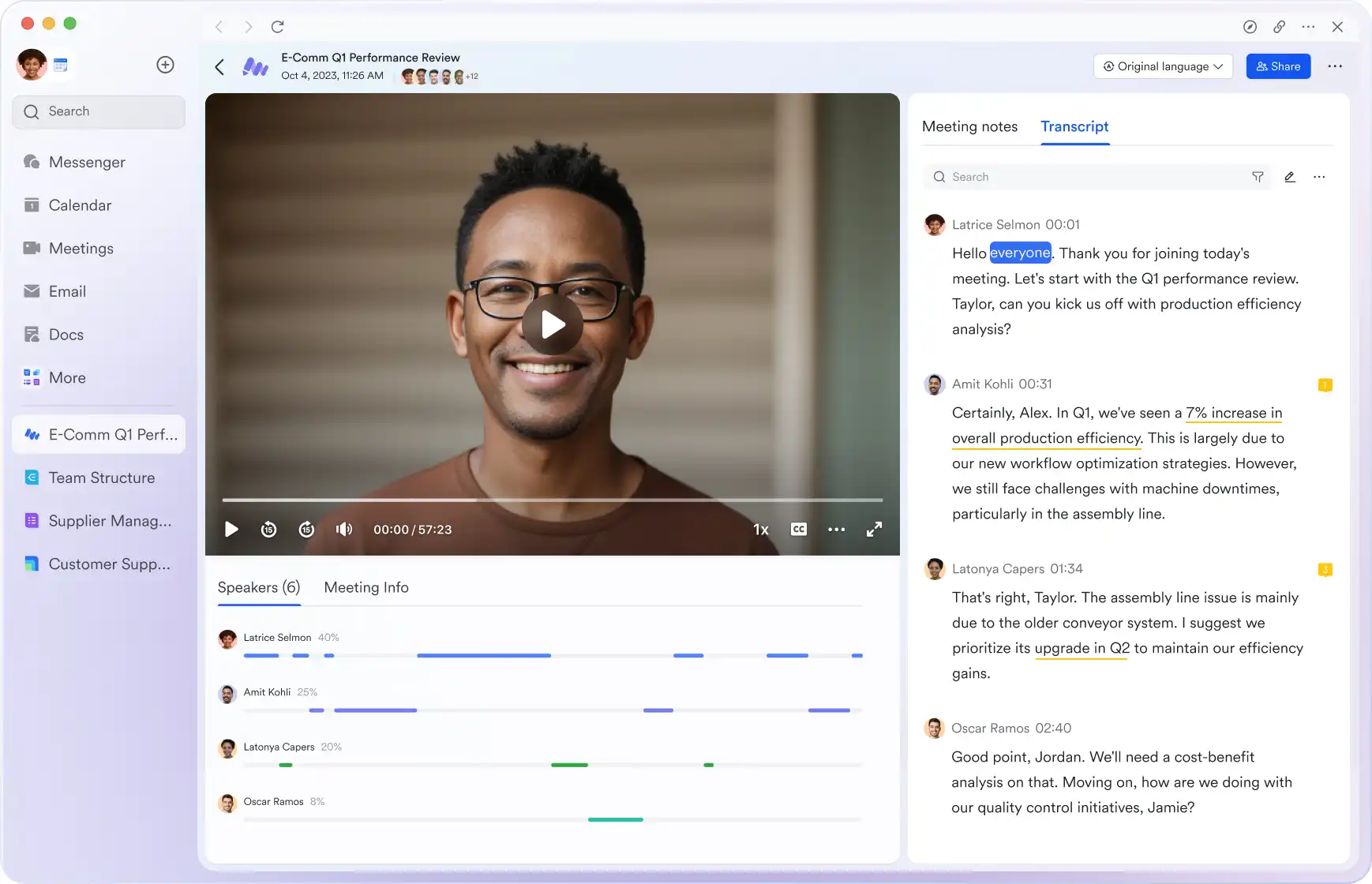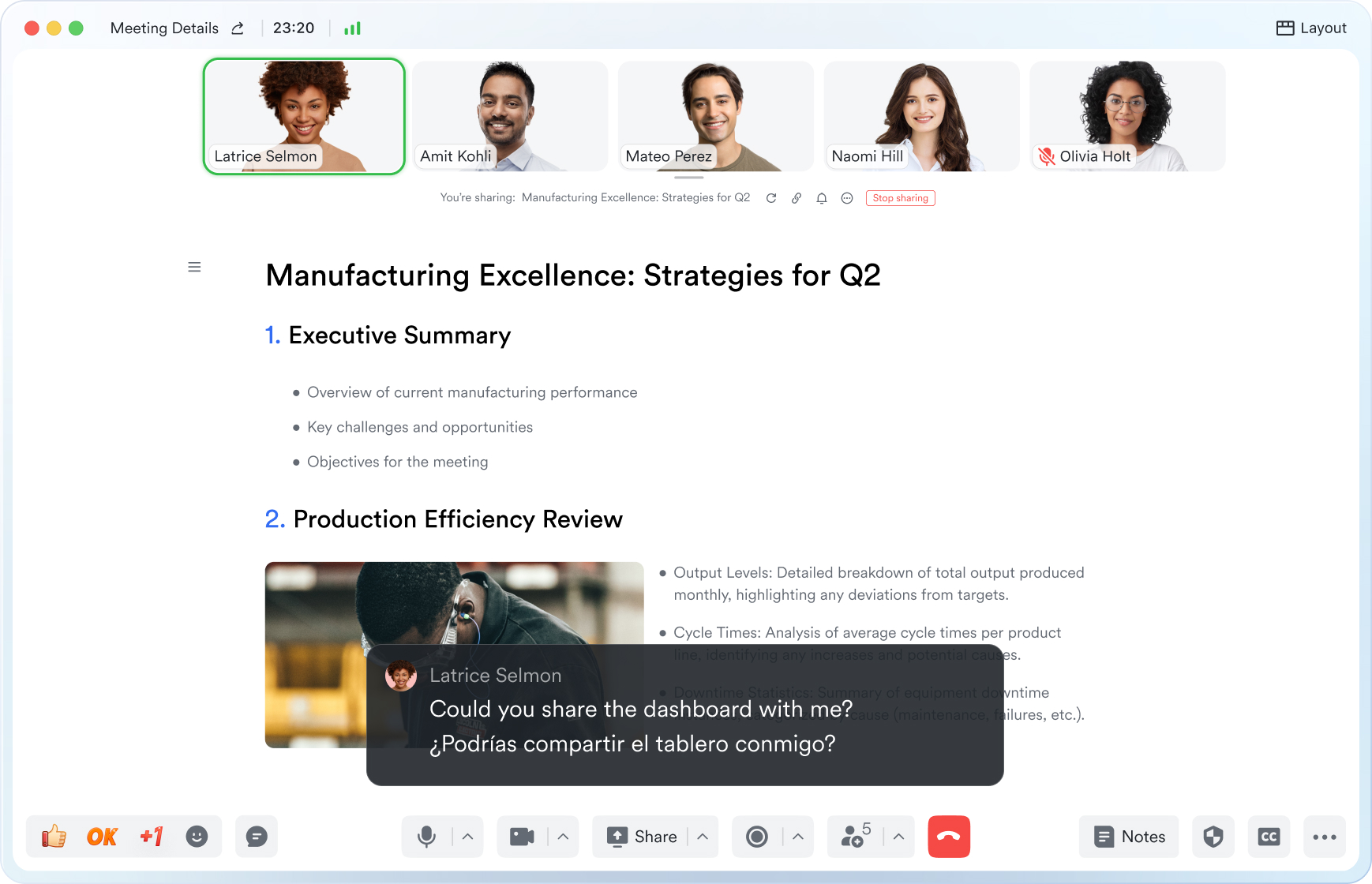Emergency Meeting
This guide will walk you through the essential elements of use emergency meeting to keep your attendees aligned and engaged.
Try Lark for Free
In the modern business landscape, the ability to run a successful emergency meeting is a critical skill that can make or break an organization's capacity to navigate unforeseen challenges effectively. From swift decision-making to strategizing in response to urgent matters, the significance of emergency meetings cannot be overstated. This comprehensive guide aims to provide actionable insights, best practices, and essential strategies for hosting and managing successful emergency meetings in 2024.
Use Lark Meetings to turn meetings into true collaborative experiences.
What is an emergency meeting?
Emergency meetings are impromptu gatherings convened to address urgent and critical matters that require immediate attention. These meetings are specifically designed to facilitate rapid decision-making and problem-solving, often occurring outside the regular meeting schedule. In 2024, the dynamic business environment demands agile responses to unforeseen events, making emergency meetings indispensable for efficient crisis management and strategic adaptation.
Goals of emergency meetings
The primary goal of an emergency meeting is to resolve immediate issues and make crucial decisions promptly to address urgent situations. These meetings also aim to ensure that all relevant stakeholders are informed, engaged, and aligned with the required course of action. In 2024, the goals of emergency meetings are specifically focused on leveraging technology, ensuring transparency, and maintaining business continuity in the face of unforeseen challenges.
Who should attend emergency meetings?
The attendees of an emergency meeting should include key decision-makers, subject matter experts, and individuals directly involved in or impacted by the urgent matter at hand. In 2024, the attendees are expanded to incorporate digital security experts, technology specialists, and crisis management teams, reflecting the evolving nature of potential emergencies.
Learn more about Lark x Meetings
Topics, agenda, and structure of emergency meetings
The agenda for an emergency meeting must be meticulously crafted to address the urgent matter comprehensively. This includes defining the issue at hand, formulating potential solutions, and laying out an action plan for immediate execution. The structure of the meeting should prioritize the most critical discussions, maintain a strict time frame, and ensure active participation from all attendees. In 2024, the agile structure of emergency meetings will include time slots for virtual breakout sessions, Q&A segments, and real-time data analysis to facilitate informed decision-making.
Learn more about Lark x Meetings
How often do emergency meetings occur?
The frequency of emergency meetings varies based on the industry, the scope of operations, and the nature of potential crises. In fast-paced sectors such as finance, technology, and healthcare, emergency meetings may occur more frequently due to the rapidly evolving risk landscape. Balancing the frequency of emergency meetings with the routine operations of an organization is crucial to ensure that these meetings remain effective and purposeful.
Key differences between emergency meetings and another similar meeting
Emergency meetings differ from regular or planned meetings primarily in their urgency and focus. While regular meetings are scheduled in advance and are often recurring, emergency meetings are convened on an ad-hoc basis to address specific critical issues. The level of preparation, the sense of urgency, and the expected outcomes also distinguish emergency meetings from other corporate gatherings.
Related:
Master the Art of Meeting Notes with Lark for Enhanced Collaboration | Lark Blog | Lark BlogLearn more about Lark x Meetings
Three practical examples of emergency meetings
Resolving a legal dispute
Resolving a legal dispute
In a scenario where an organization is faced with a sudden legal challenge, such as an unforeseen lawsuit or regulatory compliance issue, an emergency meeting may be called to assess the situation, engage legal counsel, and devise an immediate response strategy.
Mitigating a financial crisis
Mitigating a financial crisis
In response to a sudden economic downturn, financial market turbulence, or a significant unexpected financial loss, an emergency meeting can be instrumental in formulating a rapid financial recovery plan, re-evaluating budgets, and reallocating resources to mitigate the impact.
Managing a major operational issue
Managing a major operational issue
When an organization encounters a critical operational obstacle, such as a supply chain disruption, a cybersecurity breach, or a large-scale system failure, an emergency meeting can align cross-functional teams to swiftly address the issue, minimize disruptions, and implement contingency measures.
Common pitfalls of emergency meetings
- Lack of Preparation: Inadequate preparation can lead to chaotic discussions and impede the decision-making process.
- Unclear Agenda: Failing to define a clear agenda can result in unfocused discussions and prolonged meetings.
- Overlooking Stakeholder Involvement: Neglecting to include key stakeholders can diminish the effectiveness of an emergency meeting.
Mitigating these pitfalls requires meticulous planning, effective communication, and proactive engagement to ensure the success of emergency meetings in handling unexpected challenges.
Learn more about Lark x Meetings
Dos and don’ts of emergency meetings
| Do's | Don'ts |
|---|---|
| Clearly communicate the urgency | Overwhelm participants with unnecessary data |
| Prioritize active engagement | Procrastinate decisions |
| Define actionable follow-up actions | Allow personal conflicts to disrupt the meeting |
| Encourage diverse perspectives | Disregard relevant stakeholder input |
Embracing these best practices while avoiding common pitfalls is crucial in conducting productive and successful emergency meetings in 2024.
What makes a virtual emergency meeting successful?
Hosting a successful virtual emergency meeting in 2024 involves leveraging advanced digital communication tools, cybersecurity measures, and real-time collaboration platforms to ensure seamless coordination and decision-making. Strategically integrating virtual breakout sessions, interactive polls, and instant messaging functionalities can enhance participant engagement and productivity in the virtual emergency meeting environment.
Learn more about Lark x Meetings
Typical takeaways of an emergency meeting
The key takeaways from an emergency meeting include decisive action plans, assigned responsibilities, and clear measures of accountability. Additionally, emergency meetings often generate valuable insights, highlighting areas of improvement, and identifying potential vulnerabilities within an organization, contributing to enhanced overall preparedness and resilience.
Questions to ask in an emergency meeting
Asking pertinent questions during an emergency meeting is crucial for gaining a comprehensive understanding of the urgent matter and formulating effective responses. Some critical questions to consider include:
- What are the immediate repercussions of this situation?
- How can we leverage our existing resources to address this emergency?
- What are the potential long-term impacts and implications of the decisions made in this meeting?
- Are there any regulatory or compliance considerations that need to be factored into our response strategy?
Asking targeted and insightful questions can elicit valuable information and perspectives, guiding the course of action during an emergency meeting in 2024.
Learn more about Lark x Meetings
Conclusion
Mastering the art of hosting a successful emergency meeting in 2024 is an essential skill for modern businesses to navigate the ever-evolving landscape of challenges and opportunities. By understanding the core elements of an emergency meeting, including its goals, structures, and potential pitfalls, organizations can proactively prepare to address unforeseen situations effectively, ensuring resilience and continuity in the face of adversity.
Use Lark Meetings to turn meetings into true collaborative experiences.
A Game Changer for Emergency Meeting: Empower your team with Lark Meetings
In the fast-paced and dynamic world of modern business, effective communication and collaboration are crucial for success of Emergency Meeting. Here we introduce Lark Meetings to serve as a centralized hub for all communication needs.
Transform your meetings into collaborative endeavors

Leverage the potency of in-call document sharing, intelligent meeting minutes, and mobile-optimized features to enhance productivity collaboratively, irrespective of your location or schedule.
Seamlessly collaborate in real-time, across any device

Share live documents instead of just screen views. Participants can navigate and edit simultaneously within the video call window, even while on the move.
Shift your focus to engagement, not note-taking

Lark Minutes automatically converts video meetings into transcripts, facilitating easy viewing, searching, and collaborative editing. Stay in the loop asynchronously, even if you can't attend the live meeting. Lark Minutes for meeting minutes support translation into 10+ different languages.
Break language barriers in communication

Lark Meetings provide real-time translation for subtitles, allowing individuals from diverse backgrounds to express themselves in their native languages. Ensure every voice is heard, regardless of geographical location. Live subtitles currently support translations from English, Chinese, and Japanese to 10+ different languages. See more translation feature in Lark.
Connect with larger audiences
Host dynamic online meetings and events accommodating up to 1,000 participants, with the flexibility of up to 50 breakout sessions for intimate group discussions within the larger meeting context. Try more Lark features for free.








